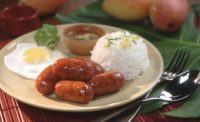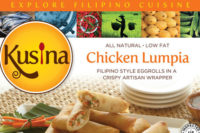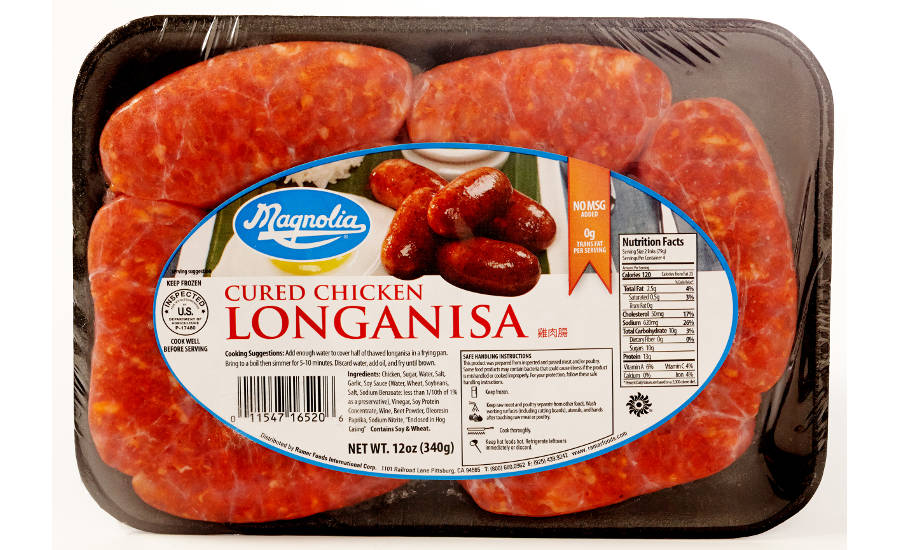Prime Cuts news
Filipino culture & cuisine: An interview with Ramar Foods


















Filipino cuisine was listed in many articles as one of the hottest ethnic trends for 2016, and that trend is sure to carry over to this year as well. As consumers become more aware of the differences in regional cuisine, a generic term like “Asian food” doesn’t really satisfy anymore. While some of the native dishes to the Philippines have close ties to dishes from Japan or China, there are other influences at play that make the food stand out.
Ramar Foods is a third-generation producer of Filipino cuisine, located in Pittsburg, Calif. Since its start in the 1960s, the company has produced more than one billion lumpia (a Filipino-style spring roll). It also makes, under a variety of brand names, filled steamed buns, meat skewers, longanisa sausages and ice cream. I had the chance to speak with PJ Quesada, vice president of Ramar Foods, about not only his family’s business but also about Filipino food trends in general.
Can you tell me a little about Ramar Foods and how it got its start?
It was started by my grandparents in the late 1960s. When my grandparents on my father’s side were living in the Philippines, they ran the Kentucky Fried Chicken franchise in the Philippines. When they moved to the United States, my grandmother, who was a teacher, opened up 11 different businesses, one for each of her 11 children to hopefully take over. While it didn’t quite work out that way, a number of those businesses were food businesses — bakeries, small quick-service restaurants — and one of those businesses was called at the time Orientex. That was an importer, distributor and small retailer of Asian food products. That little company is what eventually morphed into Ramar Foods.
We process all of our products in Northern California in our own manufacturing facilities. We serve primarily the Filipino and general Asian population. The Filipino population is probably our core. According to the U.S. census, there are a little more than four million registered Filipinos living in the United States. They are concentrated primarily in California — a little over half are located in California. The rest are spread out in the major metropolitan areas, like Chicago and the New Jersey/New York metro areas are the other large pockets. We do serve almost every state, including Alaska.
Filipino cuisine has been gaining in popularity, outside of the ethnic population. What trends has your company seen?
There are a few factors that we’ve noticed that are making a big difference in terms of how consumers are perceiving Asian foods. The first is definitely the advent of social media. Social media has not only changed how we communicate, but it’s really influenced what we consider as entertainment. There is one piece of content that cannot be replicated on social media, and that is the food experience. While there are a lot of images of food shared on social media, the only way to really experience that is to actually go try it yourself. We have been seeing a lot of discussion around food identities on social media. Because you have so many people who are either very knowledgeable about different types of food or are from a specific ethnicity, they tend to be very vocal about how their food is different from other Asian foods.
The second influence is the advent of food travel and food as a form of entertainment. There are the travel show hosts like Anthony Bourdain or Andrew Zimmern who are traveling to these countries or the Filipino communities to gain an understanding of how that culture has adapted to life in this country, using food as one of the prime narrative devices. When you combine the diverse population, the advent of social media the advent of food as entertainment, I think you have this trifecta of knowledge being shared at a rapid rate, and people are becoming fans.
Have you seen more interest in your products as a result of these trends?
That is definitely happening more and more. There’s something really interesting about the Filipino community here. They came to this country speaking full-blown English, so we became a lot more embedded much faster than our other Asian neighboring immigrants. We would attend whatever church was in our vicinity, but we would view our own food as something that we would only eat at home.
Colonialism taught Filipinos, or at least the last generation of Filipinos that have this institutional memory of Spanish colonizers and then American colonizers. [They came] into the Philippines and [told] us that our food was not good, that it was not nutritious.
Of the generation of Filipinos that are growing up in the United States, that majority of us, myself included, are of mixed heritage. I’m part Irish-American and part Filipino, for example. I’m finding a need to reach out and understand my own culture and my place in it, and what that means for me as a person. We’re seeing a lot of people who are shedding off the old, shameful aspects that our parents might be carrying about our cuisine, and we’re starting to experiment with it and share with our friends. That’s been kind of the front line of the Filipino cuisine movement. Now today, we have a new generation of restauranteurs who are being extremely bold and daring, opening up their own projects and reinterpreting Filipino cuisine for today’s market.
How would you characterize Filipino food?
The quick, essential flavor profile for most Filipino cuisine is that of sourness. That’s often personified using vinegar – there are actually many types of vinegars that are native to the Philippines and are used in cooking. We use a lot of citrus. There is a native citrus that’s very similar to the key lime, but we call it calamansi. We also use tamarin. These are all excellent souring agents that create a very unique flavor profile.
When these kind of traditional sour flavors were, over time, mixed with Western cooking techniques and imported ingredients, that’s where the magic is in Filipino cuisine. Its uniqueness is most likely a product of some of the hardships the country has gone through, rather than any purposeful or intentional innovation on the cuisine. We see more innovation today, but over the last few hundred years of colonial rule in the Philippines, it was more an act of necessity to adapt native dishes to these imported ingredients or whatever the Spanish rulers at the time would be willing to eat.
Trying to describe Filipino cuisine has been difficult, because it is essentially Southeast Asian cuisine that has some Spanish influence, and then you add all these Spanish words into the mix, and it becomes very hard for people to pinpoint exactly what it is.
What are your most popular meat products?
Aside from the lumpia, of course, our sausage products are extremely popular, our longanisa. We actually manufacture this product under three separate brands. Each brand is designed to cater to a slightly different flavor profile, and that’s usually related to the region of the Philippines that the consumer ultimately came from. So in that sense, the nuance within Filipino food becomes intensely regional. Every country has regional specialties or regional differences, or even a competition between those regions. The Philippines has over 7,000 islands, so you can imagine the regionality and the confusion over what is the right way to make a certain dish or the wrong way to make a dish. That can become a pretty passionate conversation!
One of our other very popular products is one that we adapted from our Chinese neighbors several hundred years ago, and that is steamed buns. It is a cooked sweet pork that is enrobed in a wheat dough that’s then steamed.
I tried one of your longanisa sausages, and I found it had a sweeter taste profile.
There are different regions of the Philippines, of course. The region that originated Filipino sausage was called Vigan. They are known for cooking extremely sour flavors. One of our longanisa sausage products is cooked in that style, and we use vinegar and garlic as the primary flavoring components. It’s actually more sour and more savory than the typical American breakfast sausage. The one you probably had is a much more popular flavor today, and it comes from a different region of the Philippines which is known for adding a new hint of sweetness. The next time you have some of that sweet sausage, try dunking it in vinegar. It’s magical what happens when you dunk it in vinegar.
Unlike the longer sausages you normally see, the longanisa sausages were shorter, linked sausages. Is that the traditional look?
Yes, that is the standard look. The Spanish are actually the ones that brought the sausage making process to the Philippines. The Philippines, being a developing country, smaller portions are typically what the order of the day are, so the smaller links became quite popular. There are some varieties that have longer links, but you’re more likely to see the smaller ones.
How do you balance the traditions of Filipino foods while staying current in the marketplace?
That’s an excellent question. Our core customer base, over the past few years, has shifted from being immigrants who grew up in the Philippines. We’re now seeing a shift toward people who either grew up in the United States or are overseas Filipino workers. They grew up in the Philippines in more or less the modern age, and in the Philippines, Western shopping habits and Western trends are actually quite popular. So the challenge for a company like us is how do we understand where those shoppers are going, versus the immigrant population that originally came starting in the ‘60s.
We understand that this new generation of Filipinos is shopping more and more in the American supermarkets like Safeway and Trader Joe’s, Kroger, Whole Foods etc. We’ve been focusing on the traditional products in the Asian supermarket sector and taking some of our more bold, innovative steps in the American or general market sector. For example, when you go to a Whole Foods, there’s already a couple of egg roll type products that would compete with our lumpia, so we’ve created a completely gluten-free lumpia so that for those that have a gluten sensitive diet, for whatever reason, they have a viable alternative to eating something that might make them sick. That process has taught us quite a few things about how that market works and how differently it works in the Asian supermarket sector.
What do you see in the future for Ramar Foods?
We are always working on new products. Because it is so difficult to get true consumer trend data, we do have to work with more qualitative analysis. We do have a number of projects that we have lined up over the next couple of years in terms of new products. One of the big focuses that we’ve been taking is looking internally at how we make our products and adopting some of the principles of lean manufacturing.
Our focus prior to last year was new products, new markets, aggressive in sales. Now we have a sales team that is working on stabilizing some of the new markets we’ve opened in the past couple of years like our international markets, etc. We’re now taking a very introspective look at how we conduct our day-to-day business. Even though every company can say they’re always trying to improve things, we’re probably one of the few that focuses on Asian food manufacturing to formally adopt some of these principles at a large scale.
Looking for a reprint of this article?
From high-res PDFs to custom plaques, order your copy today!
















